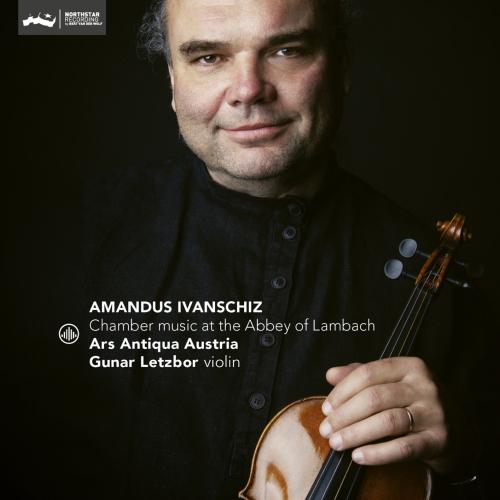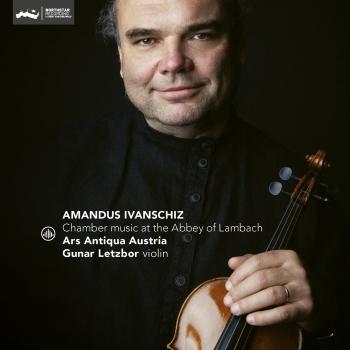
Chamber Music at the Abbey of Lambach Ars Antiqua Austria
Album info
Album-Release:
2022
HRA-Release:
04.11.2022
Label: Challenge Classics
Genre: Classical
Subgenre: Chamber Music
Artist: Ars Antiqua Austria
Composer: Amandus Ivanschiz (1727-1758)
Album including Album cover Booklet (PDF)
- Amandus Ivanschitz (1727 - 1758): Divertimento in C-Dur für Violine, Viola und Violoncello:
- 1 Ivanschitz: Divertimento in C-Dur für Violine, Viola und Violoncello: Adagio 04:05
- 2 Ivanschitz: Divertimento in C-Dur für Violine, Viola und Violoncello: Menuetto - Trio 04:55
- 3 Ivanschitz: Divertimento in C-Dur für Violine, Viola und Violoncello: Finale: Allegro 01:16
- Sinfonia in A Dur für Violine 1, Violine 2, Basso:
- 4 Ivanschitz: Sinfonia in A Dur für Violine 1, Violine 2, Basso: Andantino 02:37
- 5 Ivanschitz: Sinfonia in A Dur für Violine 1, Violine 2, Basso: Menuet 03:11
- 6 Ivanschitz: Sinfonia in A Dur für Violine 1, Violine 2, Basso: Finale 01:21
- Sinfonia ex G:
- 7 Ivanschitz: Sinfonia ex G: Violino Primo, Violino Secundo, Cornu Primo, Cornu Secundo, Viola con Basso: Allegro assai 03:10
- 8 Ivanschitz: Sinfonia ex G: Violino Primo, Violino Secundo, Cornu Primo, Cornu Secundo, Viola con Basso: Andante 02:57
- 9 Ivanschitz: Sinfonia ex G: Violino Primo, Violino Secundo, Cornu Primo, Cornu Secundo, Viola con Basso: Menuet-Trio-Menuet 02:51
- 10 Ivanschitz: Sinfonia ex G: Violino Primo, Violino Secundo, Cornu Primo, Cornu Secundo, Viola con Basso: Allegro 02:02
- Concertino in Es:
- 11 Ivanschitz: Concertino in Es: Violino, Alto Viola, Basso: Largetto 02:22
- 12 Ivanschitz: Concertino in Es: Violino, Alto Viola, Basso: Menuet-Trio-Menuet 04:30
- 13 Ivanschitz: Concertino in Es: Violino, Alto Viola, Basso: Allegro 01:27
- Sonata a 3 in B:
- 14 Ivanschitz: Sonata a 3 in B: Violino, Viola obligato e Basso: Adagio 03:17
- 15 Ivanschitz: Sonata a 3 in B: Violino, Viola obligato e Basso: Menuetto-Trio-Menuetto 06:10
- 16 Ivanschitz: Sonata a 3 in B: Violino, Viola obligato e Basso: Finale/Allegro 01:19
- Sinfonia in D a 4 Stromenti:
- 17 Ivanschitz: Sinfonia in D a 4 Stromenti: Violino 1, Violino 2, Viola obligato e Basso: Entrada/Allegro 02:55
- 18 Ivanschitz: Sinfonia in D a 4 Stromenti: Violino 1, Violino 2, Viola obligato e Basso: Menuetto-Trio-Menuetto 03:24
- 19 Ivanschitz: Sinfonia in D a 4 Stromenti: Violino 1, Violino 2, Viola obligato e Basso: Andante 04:17
- 20 Ivanschitz: Sinfonia in D a 4 Stromenti: Violino 1, Violino 2, Viola obligato e Basso: “Il Fabro ferraro”/Allegro 01:32
Info for Chamber Music at the Abbey of Lambach
Amandus Ivanschiz was baptised Matthias Leopold Ivanschiz on 24 December 1727 in the Austrian city of Wiener Neustadt. As early as 1742, at the age of fifteen, Matthias decided to join the Pauline Order and took the name Amandus. On 25 December 1743 Amandus took his vows and was then sent to Maria Trost and Wiener Neustadt to study for the priesthood.
The extensive oeuvre of this master, who only lived to the age of 31, is astonishing. In total, more than 300 copies of his works can be found in Central and Eastern Europe. His modern style and great compositional mastery probably explain the wide dissemination of his music. Ivanschiz might therefore also have served as a model in the development of the young Mozart. Amadeus’ first visit to the monastery is documented on 12 September 1767, after which we know he returned at least another three times.
Ars Antiqua Austria
Gunar Letzbor, baroque violin
Ars Antiqua Austria
was founded in Linz in 1989 with the aim of introducing audiences to the roots of specifically Austrian baroque music played on period-instruments. The music performed at the imperial court in Vienna at this period shows the strong influence of Italy and later of French forms, while Spanish court ceremonials also shape the character of the works. The typical Austrian sound of the period also betrays the influence of the many Crownlands. The political and social boundaries of Austria in the baroque era were far wider than in the 20th century. Elements of Slav and Hungarian folk music mingle with alpine sounds and can be heard in the art music of the period. The Austrian sound also reflects the temperament and character of the Austrians of that period - a unifying element in the melting-pot of many different cultures: the joie de vivre of the South, Slav melancholy, French formality, Spanish pomp and the Alpine character of the German-speaking regions. This fusion of court- with folk music and a strong element of dance music form the typical Austrian sound.
The core of Ars Antiqua Austria comprises 8 musicians directed by Gunar Letzbor. The ensemble is readily augmented to accommodate a still wider repertoire..
During its early years ARS ANTIQUA AUSTRIA gave numerous concerts while researching the achievements of Austria`s baroque composers in depth. Thanks to Gunar Letzbor's unflagging commitment, many works received their first performance in modern times. Enthusiastic reviews welcomed CDs of music by Weichlein, Biber, Conti (together with the mezzosoprano Bernarda Fink), Viviani, Mealli, Arnold, Caldara, Aufschnaiter, Vilsmayr, Vejvanovsky, Schmelzer, Muffat, Hochreither, Mouthon, Radolt, Aumann and of course J.S.Bach.
In 2002 Ars Antiqua Austria commenced a cycle of concerts in the Vienna Konzerthaus on the theme of Austrian Baroque music, since 2008 also in the Brucknerhaus Linz. Beginning in 2001 the ensemble is playing a leading part in a concert series with more than 90 concerts called "Sound of Cultures - Culture of Sound". Ten different programmes will being repeated in Vienna, Prague, Bratislava, Cracow, Venice, Ljubljana, Mechelen, Budapest and Lübeck.
Recent tours have taken the ensemble to the Festival de la Musique Baroque at Ribeauville; Berlin Festival of Ancient Music; Festival Printemps des Arts at Nantes; Mozartfest at Würzburg with an opera production together with Michael Schopper; Tage alter Musik at Herne; Festival de Musique de Clisson et de Loire Atlantique; Folles Journées de Nantes and Tokyo; Musée d'Unterlinden Colmar; Monteverdi Festival Cremona; Festival Baroque du Sablon; Salzburger Festspiele; Vlandern Festival; Festival Bach de Lausanne; Bologna Festival; Vendsyssel Festival; Concerti della Normale Pisa; Resonanzen Wien; Klangbogen Wien; Mafestivall Brügge…
ARS ANTIQUA AUSTRIA's recording of Viviani's "Capricci Armonici" received a Cannes Classical Award.
Gunar Letzbor
Amongst the year's finest issues we must mention Gunar Letzbor's interpretation of Biber's Rosary Sonatas. His intonation is impeccable, the sound is warm and generous, whilst his utter technical security and above all musicality is in evidence both in the devilish rapid passages and in those of heart-rending cantabile. (CD Classica)
Letzbor contributes dazzling violin playing in performances that are appropriately sombre yet pleasantly stylish. (Gramophone)
Biber's vision could not find a more sympathetic interpreter than Letzbor, blessed with vivacity, virtuosity and fiery expressiveness, but also capable of making his instrument sing in Biber’s touching melodies. (Amadeus)
Letzbor's performance is simply exceptional. He has added lustre to a composition (Biber) that has no equal in the history of western music. (La Stampa)
Gunar Letzbor studied composition, conducting and violin at Linz, Salzburg and Cologne. His encounters with Nikolaus Harnoncourt and Reinhard Goebel ignited a deep passion for period instruments and performance practice, leading him to perform extensively with Musica Antiqua Köln, the Clemencic Consort, La Folia Salzburg, Armonico Tributo Basel and the Wiener Akademie.
Gunar Letzbor founded his own ensemble, Ars Antiqua Austria, an instrumental ensemble of varying size dedicated in particular to the exploration of the rich, but neglected, baroque repertoire of his native country and its neighbours. Corollaries of this voyage of re-discovery have been not only the unexpected finds of musical masterpieces otherwise destined to languish in obscurity, but also the articulation of a uniquely central-European instrumental sound and its often deeply spiritual inspiration.
As a soloist and with Ars Antiqua Austria, Letzbor has made numerous recordings (including several world premieres), featuring works by Mozart, Bach, Biber, Muffat, Aufschnaiter, Viviani, Schmelzer, Weichlein, Vejvanovsky, Vilsmayr and Conti. Many of these CDs have received major record awards, including the Cannes Classical Award and Amadeus' Disco dell'Anno. Particulary remarkable was his world's premiere recording of Sonate for violin solo by J.J.Vilsmayr and J.P.Westhoff.
Letzbor has performed at every major baroque music festival in Europe, including the Festival de la Musique Baroque in Ribeauville, Festwochen der Alten Musik in Berlin, Festival Printemps des Arts in Nantes, Mozartfest in Würzburg, Tagen alter Musik in Herne, Folles Journees de Nantes and Tokyo, Musee d'Unterlinden Colmar, Flanders Festival, Festival Bach de Lausanne, Bologna Festival, Resonanzen Wien, Klangbogen Wien, Monteverdi Festival in Cremona, Mavestivall in Brugge, Vlandern Festival, at the Munich Staatsoper, the Salzburg Festival...
Gunar Letzbor teached at the Musikhochschule in Lübeck (Germany) and Vienna (Austria); he is a widely respected teacher, giving summer courses across Europe.
Letzbor's recording of Viviani's "Capricci Armonici" received a Cannes Classical Award.
Booklet for Chamber Music at the Abbey of Lambach










